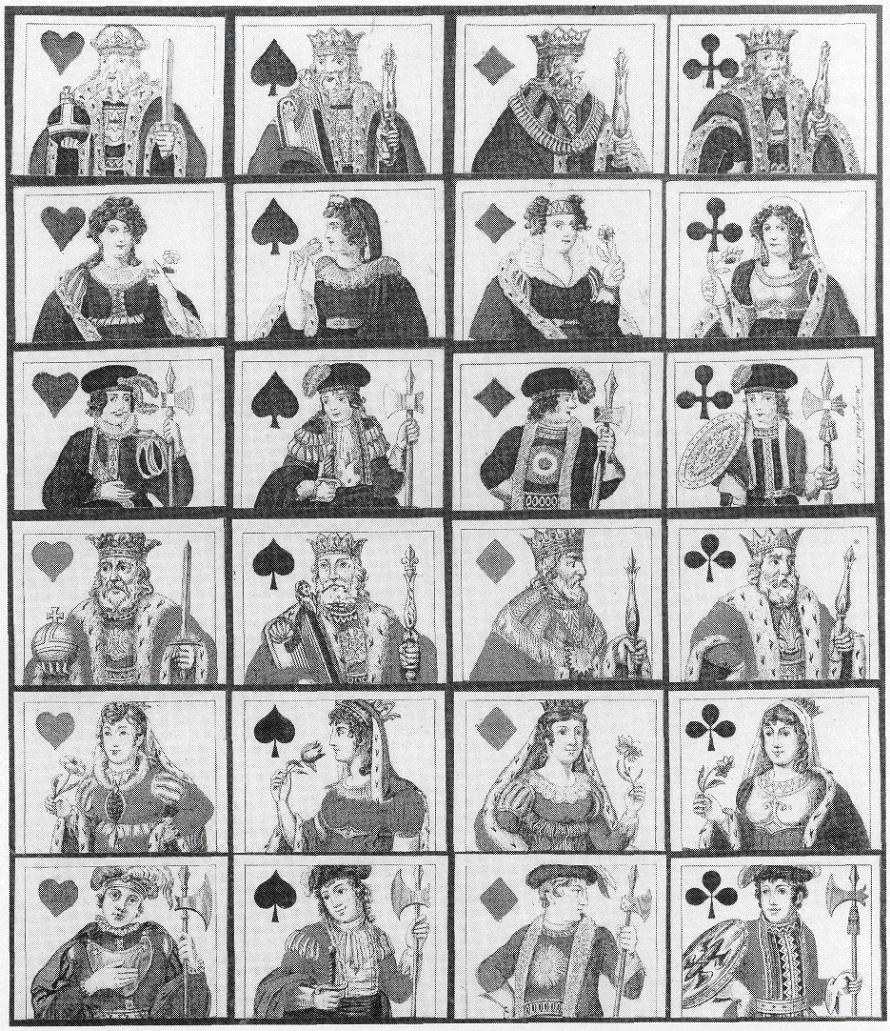

| Suit System: | F |
| Recommended Name: | no recommended name. |
Formerly labelled F-1.41 and XP6 (XP for eXpatriate Paris). The name 'International pattern' proposed by Sylvia Mann in All Cards on the Table (1990), to reflect its wide-spread production, clashes with a name often used for the English pattern [IPCS #48], and cannot be recommended.
This is one of the oldest XP patterns, showing very strong affinities with the
Paris pattern. The design had already reached Stockholm by 1815. Early German references
associate the pattern with Hamburg, and it is possible that it was just such a pattern
for which the maker Gustav Forssman asked Runge to design a new
J![]() . As illustrated overleaf,
there is a variant of XP6 whose only deviation is that the
J
. As illustrated overleaf,
there is a variant of XP6 whose only deviation is that the
J![]() is replaced by one strikingly similar to the figure which recurs in Runge's unpublished
first set of courts, which carries Forssman's name on
J
is replaced by one strikingly similar to the figure which recurs in Runge's unpublished
first set of courts, which carries Forssman's name on
J![]() .
Runge died on 2nd December, 1810.
.
Runge died on 2nd December, 1810.
Runge's teacher Gerdt Hardorff († 1864) left a signed undated etched sheet of
half-courts of XP6 pattern, which cannot have been used as it stands, and does not
seem to have been put into production. It shows little deviation from the typical
pattern, except that K![]() is fingering the strings of his harp as in Runge's design.
There is no hard evidence that this design was produced during Runge's lifetime,
nor that it was the first example of the pattern.
is fingering the strings of his harp as in Runge's design.
There is no hard evidence that this design was produced during Runge's lifetime,
nor that it was the first example of the pattern.
Cards of the XP6 pattern appear in Industrie Comptoir's samples of c.1825 as
Nos. 20 and 22 under the names of "1. Hamburger Karte" and
"2. Hamburger Karte, in Holz". In Berlin examples werebeing made c.1820 by
C.A. Müller and by C. Pfeiffer, and imported from Leipzig (possibly made by C.H. Zoelcke).
The example from Stockholm with the date 1815 is by Carl Geerds (and has non-standard
names on the Kings and Queens). The pattern was also produced by Jacob Holmblad in
Copenhagen 1820-37. J.G. Backhofen of Nuremberg made a typical example c.1845. The pattern
spread to Austria, being made by F. Eurich of Linz in 1837 and 1847. Kessman-Servaes of
Brussels c.1835 also made a version (with an unusual J![]() .
The pattern was also made in
Switzerland, by J.I. Müller of Diessenhofen c.1860 (and some earlier half-length
designs in pencil have also survived).
.
The pattern was also made in
Switzerland, by J.I. Müller of Diessenhofen c.1860 (and some earlier half-length
designs in pencil have also survived).
Most examples of the pattern follow a strict model, though non-standard
Queens and other variations do occur. As usual, the Kings are the most important:
in particular, K![]() who has his free hand evidently on his hip (as in Gatteaux's 1813
French pattern, but minus his shield), and
K
who has his free hand evidently on his hip (as in Gatteaux's 1813
French pattern, but minus his shield), and
K![]() who carries his harp high up, holding
the base in a fold of his robe as a rule.
K
who carries his harp high up, holding
the base in a fold of his robe as a rule.
K![]() in profile wears a broad striped collar or cape;
K
in profile wears a broad striped collar or cape;
K![]() holds the usual orb and sword, and the robe-
edges either side of the dividing line often form two loops round his hands (but
not in Wüst's designs). The Queens hold traditional flowers, with
Q
holds the usual orb and sword, and the robe-
edges either side of the dividing line often form two loops round his hands (but
not in Wüst's designs). The Queens hold traditional flowers, with
Q![]() in profile.
A very distinctive feature is
J
in profile.
A very distinctive feature is
J![]() who wears
an oval shield on his upper arm; this feature recurs on
J
who wears
an oval shield on his upper arm; this feature recurs on
J![]() in the
'French-Swiss' pattern [IPCS #60].
J
in the
'French-Swiss' pattern [IPCS #60].
J![]() has his free
hand on his midriff, much as in the Paris pattern prototype;
J
has his free
hand on his midriff, much as in the Paris pattern prototype;
J![]() holds a sword
beneath the hilt;
J
holds a sword
beneath the hilt;
J![]() has his head
in profile, with hand on hip.
has his head
in profile, with hand on hip.
King, Queen, Jack and numerals; usually 52 cards. Plain aces.
F.G. B(aumgärtner) in Berlin, 1815-24; Moritz Stoeckel, Leipzig, c.1825; Sutor (Naumburg) c.1850; Sydow & Rydström, Kalmar, 1814-20; C.L. Wüst made a Standard version (which he also used for a doll's house pack), as well as a pack for Brazil with swapped suits and other variations. Further variants were made by I. Kroymann in Itzehoe, c.1860, and Joseph Tetscher in Munich, c.1810 (with modish Queens).
Catalogues as for [IPCS #58], plus Playing Cards in Denmark by F. Jensen. Collections of the British Museum (Willshire and Schreiber), London; Deutsches Spielkarten Museum, Leinfelden; Museum für Kunst und Gewerbe, Hamburg.

| Top three rows: Moritz Stoeckel, Leipzig, c.1825 (Temperley collection)
Lower three rows: version with Runge-type Jack of Hearts (Ollis collection) |
| The International Playing-Card Society | 6/1997 JB |